The Wireless Communication Technologies In Healthcare Market is estimated to be valued at USD 119.0 billion in 2025 and is projected to reach USD 471.4 billion by 2035, registering a compound annual growth rate (CAGR) of 14.8% over the forecast period.
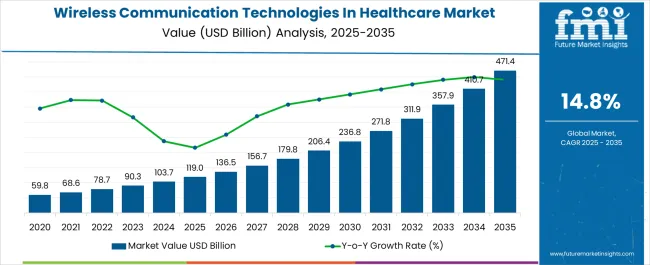
| Metric | Value |
|---|---|
| Wireless Communication Technologies In Healthcare Market Estimated Value in (2025 E) | USD 119.0 billion |
| Wireless Communication Technologies In Healthcare Market Forecast Value in (2035 F) | USD 471.4 billion |
| Forecast CAGR (2025 to 2035) | 14.8% |
The wireless communication technologies in healthcare market is witnessing significant growth, supported by the increasing integration of digital health solutions into mainstream care delivery. The market is being driven by rising demand for connected care platforms that improve accessibility, reduce hospital visits, and enhance patient engagement. Investments in 5G infrastructure, IoT-enabled medical devices, and cloud-based platforms are enabling faster data exchange, real-time monitoring, and secure communication across healthcare ecosystems.
The adoption of wireless technologies is also being supported by regulatory emphasis on patient safety, interoperability, and continuity of care. The growing need to manage chronic diseases, aging populations, and large-scale public health initiatives is further fueling demand for connected healthcare platforms.
Advances in cybersecurity protocols and AI-driven analytics are ensuring data security while enabling predictive and preventive healthcare models As digital transformation in healthcare accelerates globally, the market is expected to expand rapidly, with wireless communication technologies emerging as a cornerstone of next-generation healthcare delivery systems.
The wireless communication technologies in healthcare market is segmented by technology / system type, application, component, end user, connectivity / frequency band, and geographic regions. By technology / system type, wireless communication technologies in healthcare market is divided into Telemedicine Platforms, Integrated Communication Platforms, mHealth Applications, Wearable Devices, Wi-Fi / WLAN, Bluetooth / WPAN (Zigbee), RFID, 3G / 4G / 5G Cellular Networks, and Ultra Wide Band (UWB). In terms of application, wireless communication technologies in healthcare market is classified into Remote Patient Monitoring, Clinical Monitoring, Diagnostic Imaging, Therapeutic Devices, Asset Tracking & Inventory Management, Safety & Security, and Patient Monitoring in Labs & Pharmacies. Based on component, wireless communication technologies in healthcare market is segmented into Services, Hardware, and Software. By end user, wireless communication technologies in healthcare market is segmented into Hospitals & Clinics, Specialty Clinics, Home Care / Home Monitoring, Long-Term Care Facilities, Ambulatory Surgical Centers, Research & Academic Institutions, and Pharmaceutical & Laboratories. By connectivity / frequency band, wireless communication technologies in healthcare market is segmented into 3G / 4G / 5G Cellular, Bluetooth, NFC, Wi-Fi, Zigbee, UWB, Licensed Spectrum, and Unlicensed Spectrum. Regionally, the wireless communication technologies in healthcare industry is classified into North America, Latin America, Western Europe, Eastern Europe, Balkan & Baltic Countries, Russia & Belarus, Central Asia, East Asia, South Asia & Pacific, and the Middle East & Africa.
The telemedicine platforms segment is projected to hold 29.5% of the wireless communication technologies in healthcare market revenue share in 2025, making it the leading technology category. Its dominance is being supported by the increasing shift toward remote consultations, virtual health services, and digital-first care models. Telemedicine platforms are enabling patients to access healthcare professionals without the need for in-person visits, significantly improving convenience and efficiency.
The widespread adoption of smartphones, high-speed internet, and user-friendly mobile applications is facilitating the growth of this segment. Healthcare providers are increasingly leveraging telemedicine to reduce patient waiting times, optimize clinical resources, and expand access to underserved populations. Regulatory support for reimbursement policies in several countries has further strengthened adoption.
The COVID-19 pandemic accelerated the acceptance of telemedicine, and its continued integration into standard healthcare delivery models is ensuring sustained momentum As healthcare systems move toward hybrid care models, telemedicine platforms are expected to remain the foundation for scalable and cost-effective healthcare access.
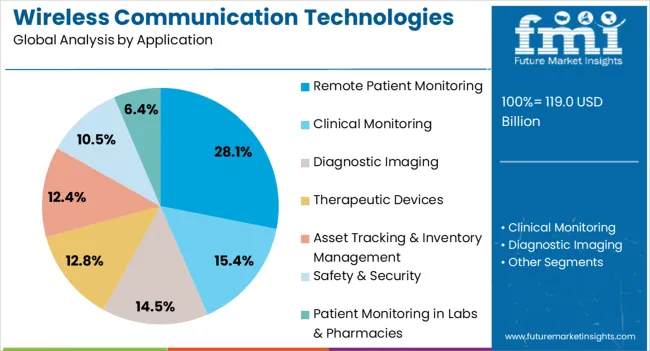
The remote patient monitoring segment is anticipated to account for 28.1% of the wireless communication technologies in healthcare market revenue share in 2025, establishing itself as the leading application area. Growth in this segment is being driven by the increasing prevalence of chronic diseases such as cardiovascular disorders, diabetes, and respiratory conditions that require continuous monitoring. Wireless communication technologies enable real-time data transmission from wearable devices, biosensors, and home monitoring systems to healthcare providers, ensuring timely interventions and improved patient outcomes.
The rising aging population and growing need for post-acute care management are reinforcing adoption. Healthcare systems are recognizing the cost-saving potential of remote monitoring by reducing hospital readmissions and enhancing preventive care.
The integration of AI and machine learning algorithms is further improving the accuracy of patient monitoring, enabling predictive healthcare solutions As value-based care models gain traction worldwide, remote patient monitoring is expected to play a central role in reducing healthcare costs while maintaining quality outcomes.
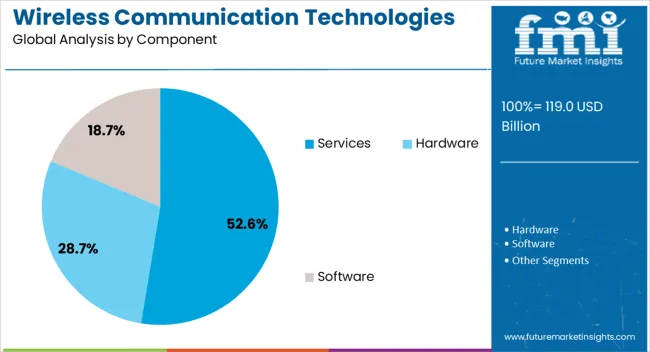
The services segment is expected to capture 52.6% of the wireless communication technologies in healthcare market revenue share in 2025, making it the largest component segment. Its leadership is being supported by the extensive need for installation, integration, maintenance, and operational support services required to deploy and manage wireless healthcare solutions. The complexity of integrating diverse technologies such as IoT devices, cloud platforms, and secure communication systems is creating sustained demand for specialized service providers.
Healthcare institutions are increasingly relying on managed service models to ensure continuous performance, compliance with regulatory frameworks, and cybersecurity resilience. The growth of telemedicine, remote monitoring, and connected medical devices is further expanding service requirements across hospitals, clinics, and home healthcare settings.
Service providers are also playing a vital role in training healthcare staff and enabling seamless adoption of new technologies As digital healthcare ecosystems expand and become more interconnected, the reliance on robust service frameworks is expected to remain a key driver of market growth.
Wireless communication is transformation of information over a distance without aid of wires, cables or any other form of electrical conductors. The distance of transmission can range from few meters to thousands of kilometers. In the healthcare industry, wireless communication is playing a vital role in transformation of information; however, the technology is still at the nascent and is expected to have massive adoption in the foreseeable future.
There is increasing demand in the healthcare industry to retrieve, store, share, and send data in various format to various devices across a particular healthcare institutions.
Various consideration are required to be made while implementing wireless communication within a healthcare institutions such as systems capacity for transmitting voice, data, and video information as well as its reliability and coverage. Few of the wireless devices used across the healthcare institutions include laptops, tablets, personal digital assistants, and healthcare smart clothes that monitor heart rate and blood pressure.
Increasing number of ageing population who requires continuous health monitoring is one of the factors which have triggered the concept of wireless technology driven human body, and is the primary factor driving the adoption of wireless communication technologies in the healthcare industry.
Examination of human body can be achieved using a network of intelligent wireless medical devices sensors which may be attached to the body surface or integrated in the tissues. It enables doctors or nurses to predict and diagnose adverse events in advance. However compatibility and interoperability issues across various healthcare device working on different communication technology are hampering the growth of the wireless communication technologies market.
North America region represent largest market opportunity for wireless communication technologies in the healthcare market. The USA and Canada are spending huge amount of money in healthcare IT to address chronic diseases. Smartphone and customized wireless healthcare solutions are acting as a catalyst for healthcare institutions to improve patient care in these countries.
In Asia-Pacific region, healthcare providers are more focused on safe, quality, and equitable healthcare services in a cost effective manner. In order to provide healthcare services to increasing chronic aging population, healthcare organizations are improving their infrastructure by deploying various wireless communication technology based infrastructure. The IT spending in healthcare on the rise in the European region.
Hospitals are increasingly adopting wireless infrastructure to co-ordinate day-to-day activities, reduce human errors, limit operational costs, and stay ahead in terms of offering customer centric quality service. In healthcare IT technology providers increasingly expanding their business in these regions. Growing private healthcare infrastructure and increasing government investments is driving the adoption of wireless infrastructure in the healthcare sector of Latin America and Middle East and Africa regions.
Allscripts Healthcare Solutions, Inc., Extreme Networks Inc., Cerner Corporation, Cisco Systems, Inc., and GE Healthcare are some of the leading player dealing with global wireless communication technologies in the healthcare industry.
Wireless Communication Technologies in Healthcare Market Segments
The report is a compilation of first-hand information, qualitative and quantitative assessment by industry analysts, inputs from industry experts and industry participants across the value chain. The report provides in-depth analysis of parent market trends, macro-economic indicators and governing factors along with market attractiveness as per segments. The report also maps the qualitative impact of various market factors on market segments and geographies.
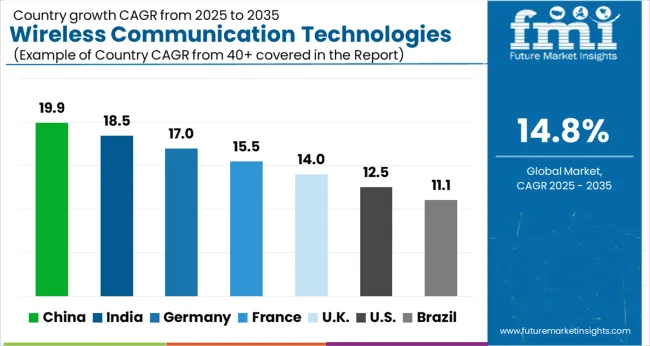
| Country | CAGR |
|---|---|
| China | 19.9% |
| India | 18.5% |
| Germany | 17.0% |
| France | 15.5% |
| UK | 14.0% |
| USA | 12.5% |
| Brazil | 11.1% |
The Wireless Communication Technologies In Healthcare Market is expected to register a CAGR of 14.8% during the forecast period, exhibiting varied country level momentum. China leads with the highest CAGR of 19.9%, followed by India at 18.5%. Developed markets such as Germany, France, and the UK continue to expand steadily, while the USA is likely to grow at consistent rates. Brazil posts the lowest CAGR at 11.1%, yet still underscores a broadly positive trajectory for the global Wireless Communication Technologies In Healthcare Market. In 2024, Germany held a dominant revenue in the Western Europe market and is expected to grow with a CAGR of 17.0%. The USA Wireless Communication Technologies In Healthcare Market is estimated to be valued at USD 41.6 billion in 2025 and is anticipated to reach a valuation of USD 135.5 billion by 2035. Sales are projected to rise at a CAGR of 12.5% over the forecast period between 2025 and 2035. While Japan and South Korea markets are estimated to be valued at USD 5.6 billion and USD 3.2 billion respectively in 2025.
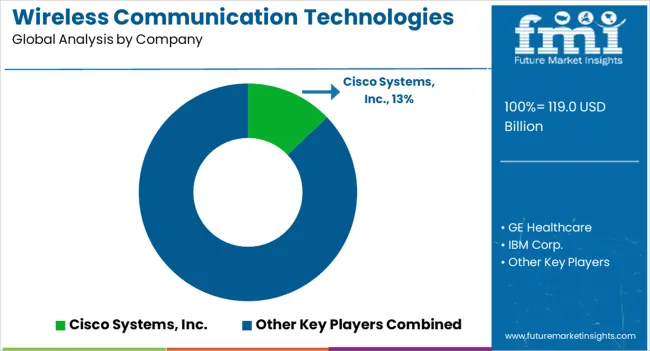
| Item | Value |
|---|---|
| Quantitative Units | USD 119.0 Billion |
| Technology / System Type | Telemedicine Platforms, Integrated Communication Platforms, mHealth Applications, Wearable Devices, Wi-Fi / WLAN, Bluetooth / WPAN (Zigbee), RFID, 3G / 4G / 5G Cellular Networks, and Ultra Wide Band (UWB) |
| Application | Remote Patient Monitoring, Clinical Monitoring, Diagnostic Imaging, Therapeutic Devices, Asset Tracking & Inventory Management, Safety & Security, and Patient Monitoring in Labs & Pharmacies |
| Component | Services, Hardware, and Software |
| End User | Hospitals & Clinics, Specialty Clinics, Home Care / Home Monitoring, Long-Term Care Facilities, Ambulatory Surgical Centers, Research & Academic Institutions, and Pharmaceutical & Laboratories |
| Connectivity / Frequency Band | 3G / 4G / 5G Cellular, Bluetooth, NFC, Wi-Fi, Zigbee, UWB, Licensed Spectrum, and Unlicensed Spectrum |
| Regions Covered | North America, Europe, Asia-Pacific, Latin America, Middle East & Africa |
| Country Covered | United States, Canada, Germany, France, United Kingdom, China, Japan, India, Brazil, South Africa |
| Key Companies Profiled | Cisco Systems, Inc., GE Healthcare, IBM Corp., AT&T, Inc., Verizon Communications, Inc., Koninklijke Philips N.V., Qualcomm, Inc., Cerner Corporation, Allscripts Healthcare Solutions, Inc., Schneider Electric SE, Motorola Solutions, Inc., Nokia Corporation, Omron Corporation, Telstra Health Pty Ltd., and Airtower Networks |
The global wireless communication technologies in healthcare market is estimated to be valued at USD 119.0 billion in 2025.
The market size for the wireless communication technologies in healthcare market is projected to reach USD 471.4 billion by 2035.
The wireless communication technologies in healthcare market is expected to grow at a 14.8% CAGR between 2025 and 2035.
The key product types in wireless communication technologies in healthcare market are telemedicine platforms, integrated communication platforms, mhealth applications, wearable devices, wi-fi / wlan, bluetooth / wpan (zigbee), rfid, 3g / 4g / 5g cellular networks and ultra wide band (uwb).
In terms of application, remote patient monitoring segment to command 28.1% share in the wireless communication technologies in healthcare market in 2025.






Our Research Products

The "Full Research Suite" delivers actionable market intel, deep dives on markets or technologies, so clients act faster, cut risk, and unlock growth.

The Leaderboard benchmarks and ranks top vendors, classifying them as Established Leaders, Leading Challengers, or Disruptors & Challengers.

Locates where complements amplify value and substitutes erode it, forecasting net impact by horizon

We deliver granular, decision-grade intel: market sizing, 5-year forecasts, pricing, adoption, usage, revenue, and operational KPIs—plus competitor tracking, regulation, and value chains—across 60 countries broadly.

Spot the shifts before they hit your P&L. We track inflection points, adoption curves, pricing moves, and ecosystem plays to show where demand is heading, why it is changing, and what to do next across high-growth markets and disruptive tech

Real-time reads of user behavior. We track shifting priorities, perceptions of today’s and next-gen services, and provider experience, then pace how fast tech moves from trial to adoption, blending buyer, consumer, and channel inputs with social signals (#WhySwitch, #UX).

Partner with our analyst team to build a custom report designed around your business priorities. From analysing market trends to assessing competitors or crafting bespoke datasets, we tailor insights to your needs.
Supplier Intelligence
Discovery & Profiling
Capacity & Footprint
Performance & Risk
Compliance & Governance
Commercial Readiness
Who Supplies Whom
Scorecards & Shortlists
Playbooks & Docs
Category Intelligence
Definition & Scope
Demand & Use Cases
Cost Drivers
Market Structure
Supply Chain Map
Trade & Policy
Operating Norms
Deliverables
Buyer Intelligence
Account Basics
Spend & Scope
Procurement Model
Vendor Requirements
Terms & Policies
Entry Strategy
Pain Points & Triggers
Outputs
Pricing Analysis
Benchmarks
Trends
Should-Cost
Indexation
Landed Cost
Commercial Terms
Deliverables
Brand Analysis
Positioning & Value Prop
Share & Presence
Customer Evidence
Go-to-Market
Digital & Reputation
Compliance & Trust
KPIs & Gaps
Outputs
Full Research Suite comprises of:
Market outlook & trends analysis
Interviews & case studies
Strategic recommendations
Vendor profiles & capabilities analysis
5-year forecasts
8 regions and 60+ country-level data splits
Market segment data splits
12 months of continuous data updates
DELIVERED AS:
PDF EXCEL ONLINE
Wireless Hydrometer Market Size and Share Forecast Outlook 2025 to 2035
Wireless HDMI Transmitter and Receiver Market Size and Share Forecast Outlook 2025 to 2035
Wireless Video - 2.4/5GHz Market Size and Share Forecast Outlook 2025 to 2035
Wireless Polysomnography Market Size and Share Forecast Outlook 2025 to 2035
Wireless Audio Devices Market Size and Share Forecast Outlook 2025 to 2035
Wireless Mesh Network Market Size and Share Forecast Outlook 2025 to 2035
Wireless Sensor Tags Market Size and Share Forecast Outlook 2025 to 2035
Wireless Sensor Network Market Size and Share Forecast Outlook 2025 to 2035
Wireless Power Transmission Market Size and Share Forecast Outlook 2025 to 2035
Wireless Home Security Camera Market Size and Share Forecast Outlook 2025 to 2035
Wireless Power Bank Market Size and Share Forecast Outlook 2025 to 2035
Wireless Headphones Market Size and Share Forecast Outlook 2025 to 2035
Wireless Sensors Market Size and Share Forecast Outlook 2025 to 2035
Wireless Display Market Size and Share Forecast Outlook 2025 to 2035
Wireless Earphone Market Size and Share Forecast Outlook 2025 to 2035
Wireless Antenna Market Size and Share Forecast Outlook 2025 to 2035
Wireless Surgical Cameras Market Size and Share Forecast Outlook 2025 to 2035
Wireless Connectivity Market Size and Share Forecast Outlook 2025 to 2035
Wireless Fire Detection Systems Market Analysis - Size, Growth, and Forecast 2025 to 2035
Wireless Audio Products Market Growth & Demand 2025 to 2035

Thank you!
You will receive an email from our Business Development Manager. Please be sure to check your SPAM/JUNK folder too.
Chat With
MaRIA